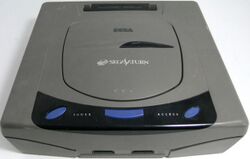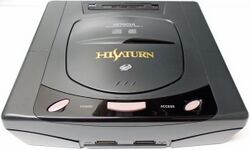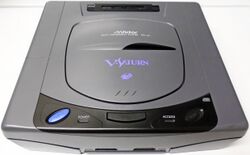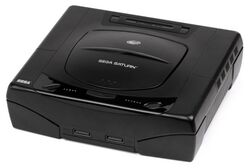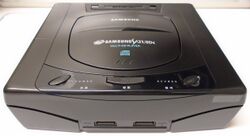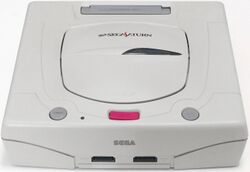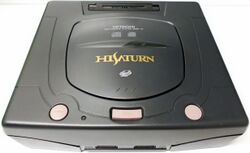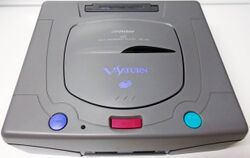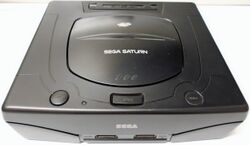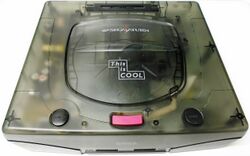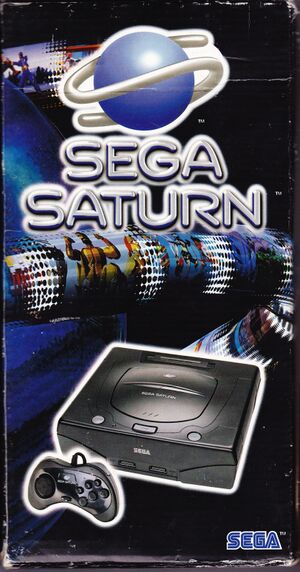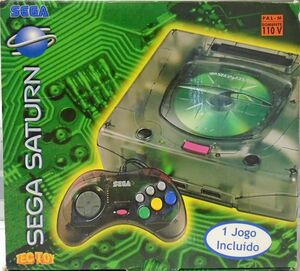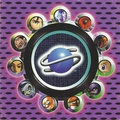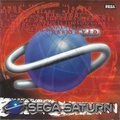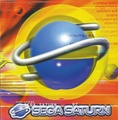Difference between revisions of "Sega Saturn"
From Sega Retro
m (→Storage) |
|||
| Line 125: | Line 125: | ||
** Geometry [[wikipedia:Digital signal processor|DSP]] @ 14.3 MHz: 32-bit fixed-point instructions, up to 4 parallel instructions | ** Geometry [[wikipedia:Digital signal processor|DSP]] @ 14.3 MHz: 32-bit fixed-point instructions, up to 4 parallel instructions | ||
** Bus width: 32-bit internal, 32-bit external | ** Bus width: 32-bit internal, 32-bit external | ||
| − | * CD-ROM CPU: Hitachi [[SuperH|SH1]] 32-bit [[RISC]] processor @ 20 MHz (20 MIPS){{fileref|Hitachi SuperH Programming Manual.pdf}} (controlling the CD-ROM) | + | * CD-ROM CPU: Hitachi [[SuperH|SH1]] 32-bit [[RISC]] processor @ 20 MHz (20 MIPS) {{fileref|Hitachi SuperH Programming Manual.pdf}} (controlling the CD-ROM) |
** Contains internal DAC and internal math processor {{fileref|Sega Service Manual - Sega Saturn (PAL) - 013-1 - June 1995.pdf}} | ** Contains internal DAC and internal math processor {{fileref|Sega Service Manual - Sega Saturn (PAL) - 013-1 - June 1995.pdf}} | ||
** Bus width: 32-bit internal, 16-bit external {{fileref|ST-103-R1-040194.pdf}} | ** Bus width: 32-bit internal, 16-bit external {{fileref|ST-103-R1-040194.pdf}} | ||
* Microcontroller: Hitachi HD404920 {{ref|https://github.com/mamedev/mame/blob/master/src/mame/drivers/saturn.cpp}} (4-bit MCU) "System Manager & Peripheral Control" (SMPC) @ 4 MHz {{fileref|Sega Service Manual - Sega Saturn (PAL) - 013-1 - June 1995.pdf}} | * Microcontroller: Hitachi HD404920 {{ref|https://github.com/mamedev/mame/blob/master/src/mame/drivers/saturn.cpp}} (4-bit MCU) "System Manager & Peripheral Control" (SMPC) @ 4 MHz {{fileref|Sega Service Manual - Sega Saturn (PAL) - 013-1 - June 1995.pdf}} | ||
** RTC: 1 MHz{{fileref|ST-103-R1-040194.pdf}} (real-time clock) | ** RTC: 1 MHz{{fileref|ST-103-R1-040194.pdf}} (real-time clock) | ||
| − | ** Instruction set: 4-bit instructions, 890 [[wikipedia:Nanosecond|ns]] per instruction,{{ | + | ** Instruction set: 4-bit instructions, 890 [[wikipedia:Nanosecond|ns]] per instruction,{{fileref|HD40491 datasheet.pdf}} 1.123595 MIPS |
** Bus width: 10-bit internal, 8-bit external {{fileref|Sega Service Manual - Sega Saturn (PAL) - 013-1 - June 1995.pdf}} | ** Bus width: 10-bit internal, 8-bit external {{fileref|Sega Service Manual - Sega Saturn (PAL) - 013-1 - June 1995.pdf}} | ||
}} | }} | ||
| Line 155: | Line 155: | ||
{{multicol| | {{multicol| | ||
* System [[RAM]]: 4640 [[Byte|KB]] (4.53125 [[Byte|MB]]) {{ref|https://github.com/mamedev/mame/blob/master/src/mame/drivers/saturn.cpp}}{{fileref|Sega Service Manual - Sega Saturn (PAL) - 013-1 - June 1995.pdf}} | * System [[RAM]]: 4640 [[Byte|KB]] (4.53125 [[Byte|MB]]) {{ref|https://github.com/mamedev/mame/blob/master/src/mame/drivers/saturn.cpp}}{{fileref|Sega Service Manual - Sega Saturn (PAL) - 013-1 - June 1995.pdf}} | ||
| − | ** 2 MB Work RAM (32-bit, 28.6364 MHz){{fileref|13-APR-94.pdf|page=8}} | + | ** 2 MB Work RAM (32-bit, 28.6364 MHz) {{fileref|13-APR-94.pdf|page=8}} |
| − | *** 1 MB High Work [[wikipedia:Synchronous dynamic random-access memory|SDRAM]] (dual-bank, 32-bit, 28.6364 MHz){{ | + | *** 1 MB High Work [[wikipedia:Synchronous dynamic random-access memory|SDRAM]] (dual-bank, 32-bit, 28.6364 MHz) {{fileref|HM5241605 datasheet.pdf}} |
| − | *** 1 MB Low Work [[wikipedia:Dynamic random-access memory|DRAM]] ([[wikipedia:FPM DRAM|FPM]], 16-bit, 22.222222 MHz){{ | + | *** 1 MB Low Work [[wikipedia:Dynamic random-access memory|DRAM]] ([[wikipedia:FPM DRAM|FPM]], 16-bit, 22.222222 MHz) {{fileref|TC514260B datasheet.pdf}} |
** 1.5 MB [[VRAM]] (SDRAM, dual-bank, 28.6364 MHz) | ** 1.5 MB [[VRAM]] (SDRAM, dual-bank, 28.6364 MHz) | ||
| − | *** 512 KB VDP1 [[sprite]]/[[wikia:w:c:gaming:Texture memory|texture cache]] (16-bit){{ | + | *** 512 KB VDP1 [[sprite]]/[[wikia:w:c:gaming:Texture memory|texture cache]] (16-bit) {{fileref|HM5241605 datasheet.pdf}} |
| − | *** 512 KB (2× 256 KB) VDP1 dual [[wikipedia:Framebuffer|framebuffers]] (16-bit per framebuffer){{ | + | *** 512 KB (2× 256 KB) VDP1 dual [[wikipedia:Framebuffer|framebuffers]] (16-bit per framebuffer) {{fileref|UPD4504161 datasheet.pdf}} |
| − | *** 512 KB VDP2 backgrounds (24-bit){{ | + | *** 512 KB VDP2 backgrounds (24-bit) {{fileref|UPD4504161 datasheet.pdf}} |
| − | ** 512 KB Sound DRAM (FPM, 16-bit, 20 MHz){{ | + | ** 512 KB Sound DRAM (FPM, 16-bit, 20 MHz) {{fileref|HM514270D datasheet.pdf}} |
| − | ** 512 KB CD-ROM cache (sub-system [[wikipedia:Data buffer|buffer]] data cache) DRAM (FPM, 16-bit, 20 MHz){{ | + | ** 512 KB CD-ROM cache (sub-system [[wikipedia:Data buffer|buffer]] data cache) DRAM (FPM, 16-bit, 20 MHz) {{fileref|TC514260B datasheet.pdf}} |
| − | ** 32 KB battery backup [[wikipedia:Non-volatile random-access memory|NV]] [[SRAM]] (8-bit, 10 MHz){{ | + | ** 32 KB battery backup [[wikipedia:Non-volatile random-access memory|NV]] [[SRAM]] (8-bit, 10 MHz) {{fileref|SRM20256L datasheet.pdf}} |
| − | * System [[ROM]]: 512 KB [[BIOS]] [[wikipedia:Mask ROM|MROM]]/[[EPROM]] (16-bit, 10 MHz) {{ref|https://github.com/mamedev/mame/blob/master/src/mame/drivers/saturn.cpp}}{{ | + | * System [[ROM]]: 512 KB [[BIOS]] [[wikipedia:Mask ROM|MROM]]/[[EPROM]] (16-bit, 10 MHz) {{ref|https://github.com/mamedev/mame/blob/master/src/mame/drivers/saturn.cpp}}{{fileref|TC574200D datasheet.pdf}} |
* Internal processor memory: 37,360 [[byte]]s (12 KB [[wikipedia:CPU cache|cache]], 5872 bytes RAM, 20 KB ROM) {{fileref|ST-103-R1-040194.pdf}}{{fileref|Sega Service Manual - Sega Saturn (PAL) - 013-1 - June 1995.pdf}} | * Internal processor memory: 37,360 [[byte]]s (12 KB [[wikipedia:CPU cache|cache]], 5872 bytes RAM, 20 KB ROM) {{fileref|ST-103-R1-040194.pdf}}{{fileref|Sega Service Manual - Sega Saturn (PAL) - 013-1 - June 1995.pdf}} | ||
** SH2: 8 KB cache (4 KB per SH2) | ** SH2: 8 KB cache (4 KB per SH2) | ||
** SH1: 4 KB cache | ** SH1: 4 KB cache | ||
** SCU: 1.25 KB DSP RAM (1 KB program, 256 bytes data) | ** SCU: 1.25 KB DSP RAM (1 KB program, 256 bytes data) | ||
| − | ** SMPC: 20,976 bytes (496 bytes 4-bit RAM, 20 KB 10-bit ROM) {{ | + | ** SMPC: 20,976 bytes (496 bytes 4-bit RAM, 20 KB 10-bit ROM) {{fileref|HD40491 datasheet.pdf}} |
** VDP2: 4 KB on-chip color RAM | ** VDP2: 4 KB on-chip color RAM | ||
* Optional [[cartridge]] RAM: 512 KB to 4.5 MB | * Optional [[cartridge]] RAM: 512 KB to 4.5 MB | ||
| Line 229: | Line 229: | ||
===Graphics=== | ===Graphics=== | ||
{{multicol| | {{multicol| | ||
| − | * Refresh rate: 60 Hz ([[NTSC]]), 50 Hz ([[PAL]]){{fileref|ST-013-R3-061694.pdf}} | + | * Refresh rate: 60 Hz ([[NTSC]]), 50 Hz ([[PAL]]) {{fileref|ST-013-R3-061694.pdf}} |
** Frame rate: 30-60 frames/sec (NTSC), 25-50 frames/sec (PAL) | ** Frame rate: 30-60 frames/sec (NTSC), 25-50 frames/sec (PAL) | ||
* [[Palette|Color palette]]: 16,777,216, with up to 16,777,216 per background{{ref|http://web.archive.org/web/20130104202921/mamedev.org/source/src/mame/video/stvvdp2.c.html}} and 32,768 (15-bit color) per sprite/texture{{ref|http://web.archive.org/web/20130104202915/mamedev.org/source/src/mame/video/stvvdp1.c.html}} | * [[Palette|Color palette]]: 16,777,216, with up to 16,777,216 per background{{ref|http://web.archive.org/web/20130104202921/mamedev.org/source/src/mame/video/stvvdp2.c.html}} and 32,768 (15-bit color) per sprite/texture{{ref|http://web.archive.org/web/20130104202915/mamedev.org/source/src/mame/video/stvvdp1.c.html}} | ||
| Line 264: | Line 264: | ||
** Versions: Sega 315-5883 ([[Hitachi]] HD64440) Video Display Processor 1 (VDP1),{{ref|https://github.com/mamedev/mame/blob/master/src/mame/drivers/saturn.cpp}} Sega 315-5689 VDP1{{fileref|Sega Service Manual - Sega Saturn (PAL) - 013-1 - June 1995.pdf}} | ** Versions: Sega 315-5883 ([[Hitachi]] HD64440) Video Display Processor 1 (VDP1),{{ref|https://github.com/mamedev/mame/blob/master/src/mame/drivers/saturn.cpp}} Sega 315-5689 VDP1{{fileref|Sega Service Manual - Sega Saturn (PAL) - 013-1 - June 1995.pdf}} | ||
** Adjustable video clock rate: 28.6364 MHz or 26.8426 MHz (NTSC), 28.4375 MHz or 26.8426 MHz (PAL) | ** Adjustable video clock rate: 28.6364 MHz or 26.8426 MHz (NTSC), 28.4375 MHz or 26.8426 MHz (PAL) | ||
| − | * [[wikipedia:Framebuffer|Framebuffers]]: Dual 256 KB framebuffers with rotation & scaling, three framebuffer sizes (512×256, 512×512, 1024×256){{ref|http://web.archive.org/web/20130104202915/mamedev.org/source/src/mame/video/stvvdp1.c.html}}{{fileref|ST-013-R3-061694.pdf|page=149}} | + | * [[wikipedia:Framebuffer|Framebuffers]]: Dual 256 KB framebuffers with rotation & scaling, three framebuffer sizes (512×256, 512×512, 1024×256) {{ref|http://web.archive.org/web/20130104202915/mamedev.org/source/src/mame/video/stvvdp1.c.html}}{{fileref|ST-013-R3-061694.pdf|page=149}} |
* 3D polygon capabilities: Texture mapping,{{fileref|ST-013-R3-061694.pdf}} [[wikipedia:Computer graphics lighting|lighting]],{{fileref|ST-238-R1-051795.pdf}} shading, wire-frame, flat shading, Gouraud shading{{fileref|Sega Service Manual - Sega Saturn (PAL) - 013-1 - June 1995.pdf}} | * 3D polygon capabilities: Texture mapping,{{fileref|ST-013-R3-061694.pdf}} [[wikipedia:Computer graphics lighting|lighting]],{{fileref|ST-238-R1-051795.pdf}} shading, wire-frame, flat shading, Gouraud shading{{fileref|Sega Service Manual - Sega Saturn (PAL) - 013-1 - June 1995.pdf}} | ||
* Polygon rendering performance: 200,000 texture-mapped polygons/sec, 500,000 flat-shaded polygons/sec{{ref|http://www.sega-saturn.com/saturn/other/satspecs.htm}} | * Polygon rendering performance: 200,000 texture-mapped polygons/sec, 500,000 flat-shaded polygons/sec{{ref|http://www.sega-saturn.com/saturn/other/satspecs.htm}} | ||
| Line 270: | Line 270: | ||
** [[wikipedia:Texture memory|Sprite/Texture memory]] [[wikipedia:Cache (computing)|cache]]: 512 KB{{fileref|ST-013-R3-061694.pdf|page=81}} | ** [[wikipedia:Texture memory|Sprite/Texture memory]] [[wikipedia:Cache (computing)|cache]]: 512 KB{{fileref|ST-013-R3-061694.pdf|page=81}} | ||
** Sprite/Texture size: 8×1 to 504×255 pixels{{fileref|ST-013-R3-061694.pdf|page=119}} | ** Sprite/Texture size: 8×1 to 504×255 pixels{{fileref|ST-013-R3-061694.pdf|page=119}} | ||
| − | ** Colors per sprite/texture: 16, 64, 128, 256 and 32,768 (standard resolution),{{fileref|ST-013-R3-061694.pdf|page=18}} or 16, 64, 128 and 256 (high resolution){{fileref|ST-013-R3-061694.pdf|page=29}} | + | ** Colors per sprite/texture: 16, 64, 128, 256 and 32,768 (standard resolution),{{fileref|ST-013-R3-061694.pdf|page=18}} or 16, 64, 128 and 256 (high resolution) {{fileref|ST-013-R3-061694.pdf|page=29}} |
** Sprites/Textures per frame: 512 KB sprite/texture memory, 32 [[byte]]s per sprite/texture,{{fileref|ST-013-R3-061694.pdf|page=75}} up to 16,384 sprites/textures per frame | ** Sprites/Textures per frame: 512 KB sprite/texture memory, 32 [[byte]]s per sprite/texture,{{fileref|ST-013-R3-061694.pdf|page=75}} up to 16,384 sprites/textures per frame | ||
| − | * Sprite/Texture fillrate: 28.6364 million texels/sec (NTSC), 28.4375 million texels/sec (PAL){{fileref|ST-013-R3-061694.pdf}} | + | * Sprite/Texture fillrate: 28.6364 million texels/sec (NTSC), 28.4375 million texels/sec (PAL) {{fileref|ST-013-R3-061694.pdf}} |
** Maximum [[wikipedia:Texel (graphics)|texels]] per frame: 954,546 (NTSC), 1,137,500 (PAL) | ** Maximum [[wikipedia:Texel (graphics)|texels]] per frame: 954,546 (NTSC), 1,137,500 (PAL) | ||
** Maximum texels per scanline: 3728 (NTSC), 4443 (PAL) | ** Maximum texels per scanline: 3728 (NTSC), 4443 (PAL) | ||
| Line 285: | Line 285: | ||
** Adjustable video clock rate: 28.6364 MHz (NTSC), 28.4375 MHz (PAL) | ** Adjustable video clock rate: 28.6364 MHz (NTSC), 28.4375 MHz (PAL) | ||
* Features: Transparency effects, shadowing, 2 windows for special calculations, 8×8 and 16×16 tile sizes{{ref|http://web.archive.org/web/20130104202921/mamedev.org/source/src/mame/video/stvvdp2.c.html}} | * Features: Transparency effects, shadowing, 2 windows for special calculations, 8×8 and 16×16 tile sizes{{ref|http://web.archive.org/web/20130104202921/mamedev.org/source/src/mame/video/stvvdp2.c.html}} | ||
| − | * Background planes: 7 layers (5 simultaneous parallax scrolling backgrounds, 2 simultaneous scrolling/scaling/rotating playfields){{ref|http://web.archive.org/web/20130104202921/mamedev.org/source/src/mame/video/stvvdp2.c.html}}{{fileref|ST-058-R2-060194.pdf|page=24}} | + | * Background planes: 7 layers (5 simultaneous parallax scrolling backgrounds, 2 simultaneous scrolling/scaling/rotating playfields) {{ref|http://web.archive.org/web/20130104202921/mamedev.org/source/src/mame/video/stvvdp2.c.html}}{{fileref|ST-058-R2-060194.pdf|page=24}} |
** NBG0: 16 to 16,777,216 colors, [[wikipedia:Tile engine|tilemap]] (512×512 to 1024×1024) or [[wikipedia:Bitmap|bitmap]] (512×256 to 1024×512), scrolling, scrolling, column/row/line scrolling, scaling | ** NBG0: 16 to 16,777,216 colors, [[wikipedia:Tile engine|tilemap]] (512×512 to 1024×1024) or [[wikipedia:Bitmap|bitmap]] (512×256 to 1024×512), scrolling, scrolling, column/row/line scrolling, scaling | ||
** NBG1: 16 to 32,768 colors, tilemap (512×512 to 1024×1024) or bitmap (512×256 to 1024×512), scrolling, column/row/line scrolling, scaling | ** NBG1: 16 to 32,768 colors, tilemap (512×512 to 1024×1024) or bitmap (512×256 to 1024×512), scrolling, column/row/line scrolling, scaling | ||
Revision as of 15:08, 9 November 2015
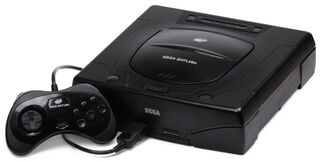
| |||||
| Sega Saturn | |||||
|---|---|---|---|---|---|
| Manufacturer: Sega | |||||
|
The Sega Saturn (セガサターン), is a video game console manufactured by Sega and was the successor to the Sega Mega Drive/Genesis (as opposed to add-ons such as the Sega 32X and Mega-CD). Initially released in 1994, the Saturn was a 32-bit compact disc-based system, and was a key player in what is now widely known as the fifth generation of video game consoles. The Saturn was first released on November 22, 1994 in Japan, May 11, 1995 in North America, and July 8, 1995 in Europe.
Depending on where you live, the Saturn could be described as either Sega's most successful console of all time (Japan) or one of their biggest commercial failures (North America). Its complex hardware and inability to meet rapidly evolving consumer expectations and demands put it in a distant third place in the Western world, but a combination of above-average 2D rendering capabilities and a strong marketing campaign made the Saturn the most successful Sega console in Japan. Estimates for the total number of Saturns sold worldwide range from ten million to seventeen million.
The Saturn's main competitors were the Sony PlayStation released in 1995 and the Nintendo 64 released in 1996. Its arcade counterpart was the Sega Titan Video (ST-V). It was replaced by the Sega Dreamcast in late 1998.
Contents
Hardware
The system uses CD-ROMs as its primary choice of media. Though it contains a cartridge slot, this is not used for games, but rather backup memory or RAM cartridges. The former was to extend the space for save games beyond that of the Saturn's internal memory, while the latter was used to augment the Saturn's limited memory and to avoid long CD load times.
The Saturn has two controller ports, and the standard Saturn controller builds on that seen in the six button Sega Mega Drive controller. It adds two shoulder buttons, first seen in the Super Nintendo, bringing the amount of buttons up to nine. The 3D Control Pad, released later with NiGHTS into Dreams, would supply the console with an analogue stick and analogue shoulder buttons, the latter later being used in the Sega Dreamcast before being adopted by Nintendo and Microsoft for their GameCube and Xbox consoles, respectively.
Models
- Main article: Sega Saturn consoles
There are a variety of Sega Saturn models of different shapes and colours, as well as novelty units, such as the Game & Car Navi HiSaturn. Differences between systems are not as drastic as seen with the Sega Mega Drive - the same basic feature set and component designs were used throughout the console's lifespan in all regions.
HST-3200/HST-3210
First seen on launch day in Japan (1994-11-22), the HST-3200 (later revised and released as the HST-3210, although the differences aside from a BIOS update are not fully understood), commonly referred to as the "grey Saturn" (although during development it had a metallic finish), was the basis for all Sega Saturns released between the Japanese launch and early 1996. These Saturns use blue "oval" buttons, mounted to black plastic at the front of the unit, and have both "power" and "access" LEDs similar to the Sega Mega CD.
The Saturn saw variants produced by Hitachi and Victor as the HiSaturn and V-Saturn respectively, though aside from altered BIOSes and aesthetics (and bundles/pricing) these do not deviate much from the Sega designs. Novelty value sees these models worth slightly more in pre-owned markets - fewer were produced than the Sega models, but compatibility rates are much the same.
Overseas versions are physically identical (save for region encoding), but use black plastic throughout.
HST-3220
Released in March 1996, the HST-3220 stands as the only significant change to the Saturn's design, although functionality wise, the only feature omitted is the "access" LED seen in previous models. These "white" Saturns likely cost less to produce, but from a user perspective the change is largely negligible - the console is roughly the same size and has no problems running any Saturn software. White Saturns opt for grey "circle" power and reset buttons and a pink "open" button for lifting the lid.
It is rumoured, though not proven, that the HST-3220 has a faster disc reading time than its earlier counterparts, meaning quicker loading screens in games.
When brought overseas the console continued to be shipped only in black, although the North American and European models have different coloured buttons. In 1998 Sega started releasing these consoles with semi-transparent plastic under the "This is cool" brand - it is not known if these versions replaced the white models, or were sold alongside them. Again aside from aesthetic differences the consoles are interchangable.
Some of the Japanese colour designs were also brought to Brazil.
BIOS
| BIOS Version | Machine | Download |
|---|---|---|
| 1.00 | Sega Saturn (Japan) | 1.00 (Asian Saturn) (info) ("Sega Saturn BIOS (1.00) (J).zip" does not exist) |
| 1.00a | Sega Saturn (NA & EU) | 1.00a (NA & EU Saturn) (info) ("Sega Saturn BIOS (1.00a) (UE).zip" does not exist) |
| 1.003 | Sega Saturn Devkit (Japan) | 1.003 (Asian Devkit) (info) ("Sega Saturn BIOS (1.003) (J).zip" does not exist) |
| 1.01 | Sega Saturn (Japan), HiSaturn (Japan), V-Saturn (Japan) | 1.01 (Asian Saturn) (info) ("Sega Saturn BIOS (1.01) (J).zip" does not exist) |
| 1.01 (Asian HiSaturn) (info) ("HI-Saturn BIOS (1.01) (J).zip" does not exist) | ||
| 1.01 (Asian V-Saturn) (info) ("V-Saturn BIOS (1.01) (J).zip" does not exist) | ||
| 1.01a | Sega Saturn (NA & EU) | 1.01a (NA & EU Saturn) (info) ("Sega Saturn BIOS (1.01a) (UE).zip" does not exist) |
| 1.02 | HiSaturn (Japan) | 1.02 (JP HiSaturn) (info) ("Bios_Hi-Saturn_1.02_(J).rar" does not exist) |
| 1.03 | HiSaturn Navi (Japan) | 1.03 (JP HiSaturn Navi) (info) ("Bios_GameNavi_HiSaturn_1.03.rar" does not exist) |
Errata
VDP1 transparency rendering quirk causes strips of pixels to be rewritten to framebuffer for 2-point (scaled) and 4-point (quadrangle) "sprites", applying the transparency effect multiple times. Rarely seen in commercial games (Robotica explosions), later titles implemented software transparency to correctly render polygons (Dural in Virtua Fighter Kids).
Technical Specifications
Processors
- Main CPU Processors: 2× Hitachi SuperH2 7604 32-Bit RISC (SH2) processors @ 28.6364 MHz [1]
- Master/Slave configuration
- Internal math processor: [2] Fixed-point arithmetic, 32-bit RISC instructions/registers @ 57.2728 MIPS (28.6364 MIPS each)
- Bus width: 32-bit internal, 32-bit external [3]
- Fixed-Point Math Coprocessor: Custom Saturn Control Unit (SCU), with DSP for geometry processing and DMA controller [3][2]
- CD-ROM CPU: Hitachi SH1 32-bit RISC processor @ 20 MHz (20 MIPS) [1] (controlling the CD-ROM)
- Microcontroller: Hitachi HD404920 [4] (4-bit MCU) "System Manager & Peripheral Control" (SMPC) @ 4 MHz [2]
Audio
- Sound Processor: Yamaha SCSP (Saturn Custom Sound Processor) YMF292 [6]
- Sound CPU: Motorola 68EC000 (16/32-bit CISC) sound processor @ 11.3 MHz (1.9775 MIPS) [3]
- Bus width: 16-bit internal, 16-bit external
Video
- Sega/Hitachi VDP1 32-bit video display processor @ 28.6364 MHz: Sprites, textures, polygons [8][4]
- Bus width: 32-bit internal, 16-bit per external bus (3 buses)
- Sega/Yamaha VDP2 32-bit background and scroll plane video display processor @ 28.6364 MHz: Backgrounds, scrolling [9][4]
- Bus width: 32-bit internal, 24-bit external
- Sony CXA1645M RGB-Composite Video Encoder [4]
Memory
- System RAM: 4640 KB (4.53125 MB) [4][2]
- 2 MB Work RAM (32-bit, 28.6364 MHz) [10]
- 1.5 MB VRAM (SDRAM, dual-bank, 28.6364 MHz)
- 512 KB VDP1 sprite/texture cache (16-bit) [11]
- 512 KB (2× 256 KB) VDP1 dual framebuffers (16-bit per framebuffer) [13]
- 512 KB VDP2 backgrounds (24-bit) [13]
- 512 KB Sound DRAM (FPM, 16-bit, 20 MHz) [14]
- 512 KB CD-ROM cache (sub-system buffer data cache) DRAM (FPM, 16-bit, 20 MHz) [12]
- 32 KB battery backup NV SRAM (8-bit, 10 MHz) [15]
- System ROM: 512 KB BIOS MROM/EPROM (16-bit, 10 MHz) [4][16]
- Internal processor memory: 37,360 bytes (12 KB cache, 5872 bytes RAM, 20 KB ROM) [3][2]
- SH2: 8 KB cache (4 KB per SH2)
- SH1: 4 KB cache
- SCU: 1.25 KB DSP RAM (1 KB program, 256 bytes data)
- SMPC: 20,976 bytes (496 bytes 4-bit RAM, 20 KB 10-bit ROM) [5]
- VDP2: 4 KB on-chip color RAM
- Optional cartridge RAM: 512 KB to 4.5 MB
- Extended RAM Cartridge: 1 MB or 4 MB Work RAM
- Saturn Backup Memory: 512 KB battery backup
- Pro Action Replay: 512 KB battery backup
- Action Replay Plus: 4.5 MB (4 MB Work RAM, 512 KB battery backup)
- Optional Video CD Card memory: 1 MB (512 KB buffer RAM, 512 KB program ROM) [2]
Configuration
- System bus (32-bit, 28.6364 MHz)
- SH2 (×2), SCU, SMPC <-> Work RAM (SDRAM, FPM DRAM), battery backup SRAM
- Video sub-system buses [8]
- VDP1 <-> Texture cache VRAM (SDRAM)
- VDP1 <-> Framebuffer 0 VRAM (SDRAM)
- VDP1 <-> Framebuffer 1 VRAM (SDRAM)
- VDP2 <-> Background VRAM (SDRAM) [17]
- Sound sub-system bus — 68EC000 & SCSP <-> Sound DRAM (FPM DRAM)
- CD-ROM sub-system bus — SH1 <-> CD-ROM cache/buffer DRAM (FPM DRAM)
Bandwidth
- Internal processor bandwidth:
- SH2 cache: 218.4 MB/sec (109.239196 MB/sec per SH2)
- SH1 cache: 76.2 MB/sec
- SCU DSP RAM: 54.5 MB/sec
- SMPC: 4.7 MB/sec (1.9 MB/sec RAM, 4.7 MB/sec ROM)
- 68EC000: 21.5 MB/sec
- SCSP: 64.6 MB/sec
- VDP: 218.4 MB/sec (114.5456 MB/sec VDP1, 114.5456 MB/sec VDP2 color RAM)
- System RAM bandwidth: 376.7 MB/sec
- System bus RAM: 109.239196 MB/sec
- Work RAM: 109.239196 MB/sec (109.239196 MB/sec SDRAM, 42.385482 MB/sec DRAM)
- Battery backup SRAM: 9.536743 MB/sec
- Video SDRAM: 191.168594 MB/sec
- VDP1: 109.239196 MB/sec (109.239196 MB/sec framebuffers, 54.6195988 MB/sec texture cache)
- VDP2: 81.929397 MB/sec (backgrounds)
- Sound DRAM: 38.146972 MB/sec
- CD-ROM cache/buffer DRAM: 38.146972 MB/sec
- System bus RAM: 109.239196 MB/sec
- System ROM bandwidth: 19.073486 MB/sec
Sound
- SCSP: [6]
- Audio channels: 32
- Sound formats: PCM, FM, MIDI, LFO
- PCM sampling: 16‑bit and 8-bit audio depth, 44.1 kHz sampling sate (CD quality), up to 32 PCM channels
- FM synthesis: 1-4 operators per FM channel, up to 32 FM channels (1-operator) or 8 FM channels (4-operator)
- LFO waveforms: 4 waveform types (Sawtooth, rectangular, triangular, white noise), up to 32 LFO channels
- CD-DA: 1 streaming CD-DA channel (16‑bit PCM, 44.1 kHz) from CD
- Stereo audio output
Graphics
- Refresh rate: 60 Hz (NTSC), 50 Hz (PAL) [8]
- Frame rate: 30-60 frames/sec (NTSC), 25-50 frames/sec (PAL)
- Color palette: 16,777,216, with up to 16,777,216 per background[18] and 32,768 (15-bit color) per sprite/texture[19]
- Color depth: 32-bit RGBA, 24-bit color with 8-bit Z-buffering and alpha transparency[7]
- Colors on screen: 71,680 (320×224) to 207,360 (720×288)
- Fillrate: 57.2728 million pixels/sec (NTSC), 56.875 million pixels/sec (PAL)
- Maximum pixels per frame: 1.909093 million (NTSC), 2.275 million (PAL)
- Maximum pixels per scanline: 7457 (NTSC), 8886 (PAL)
- MPEG Video CD Card: 704×480 resolution, 30 frames/sec, 16-bit audio with 44.1 kHz sampling,[20] up to 72 minutes on one CD[2]
Display Resolutions
The Saturn supported the following resolutions: [1]
- 320 × 224 (Lo-Res, Progressive)
- 320 × 240 (Lo-Res, Progressive)
- 320 × 448 (Interlaced)
- 320 × 480 (Interlaced)
- 352 × 240 (Lo-Res, Scanline)
- 640 × 224 (Progressive)
- 640 × 240 (Progressive)
- 640 × 448 (Interlaced)
- 640 × 480 (Hi-Res, Interlaced)
- 704 × 480 (Hi-Res, Progressive)
- 720 × 240 (Progressive)
- 720 × 448 (Interlaced)
- 720 × 480 (Hi-Res, Interlaced)
- 720 × 576 (Hi-Res, Interlaced)
VDP1
- VDP1 32-bit video display processor @ 28.6364 MHz: Handles sprite/texture and polygon drawing,[8] color calculation and shading[2]
- Framebuffers: Dual 256 KB framebuffers with rotation & scaling, three framebuffer sizes (512×256, 512×512, 1024×256) [19][21]
- 3D polygon capabilities: Texture mapping,[8] lighting,[22] shading, wire-frame, flat shading, Gouraud shading[2]
- Polygon rendering performance: 200,000 texture-mapped polygons/sec, 500,000 flat-shaded polygons/sec[23]
- Sprite/Texture capabilities: Rotation & scaling, flipping, distortion,[8][19] virtually unlimited color tables, virtually unlimited sprites,[23] System 24/32 sprite rendering system[24]
- Sprite/Texture memory cache: 512 KB[25]
- Sprite/Texture size: 8×1 to 504×255 pixels[26]
- Colors per sprite/texture: 16, 64, 128, 256 and 32,768 (standard resolution),[27] or 16, 64, 128 and 256 (high resolution) [28]
- Sprites/Textures per frame: 512 KB sprite/texture memory, 32 bytes per sprite/texture,[29] up to 16,384 sprites/textures per frame
- Sprite/Texture fillrate: 28.6364 million texels/sec (NTSC), 28.4375 million texels/sec (PAL) [8]
- Maximum texels per frame: 954,546 (NTSC), 1,137,500 (PAL)
- Maximum texels per scanline: 3728 (NTSC), 4443 (PAL)
- Maximum sprites/textures per scanline: 466 (NTSC), 555 (PAL)
- Other features: Alpha blending, clipping, luminance, shadows, transparency,[19] anti-aliasing[30]
VDP2
- VDP2 32-bit background and scroll plane video display processor @ 28.6364 MHz: Handles background and scroll planes[9]
- Features: Transparency effects, shadowing, 2 windows for special calculations, 8×8 and 16×16 tile sizes[18]
- Background planes: 7 layers (5 simultaneous parallax scrolling backgrounds, 2 simultaneous scrolling/scaling/rotating playfields) [18][31]
- NBG0: 16 to 16,777,216 colors, tilemap (512×512 to 1024×1024) or bitmap (512×256 to 1024×512), scrolling, scrolling, column/row/line scrolling, scaling
- NBG1: 16 to 32,768 colors, tilemap (512×512 to 1024×1024) or bitmap (512×256 to 1024×512), scrolling, column/row/line scrolling, scaling
- NBG2/NBG3: 16 to 256 colors, tilemap (512×512 to 1024×1024), scrolling
- RBG0: 16 to 16,777,216 colors, tilemap (512×512 to 1024×1024) or bitmap (512×256 to 512×512), scrolling, scaling & rotation
- RBG1: 16 to 16,777,216 colors, tilemap (512×512 to 1024×1024), scrolling, scaling & rotation
- Back screen: 1 bitmap background[32]
Storage
Input/Output
- Main article: Sega Saturn Accessories
- Two 16-bit bidirectional parallel I/O ports
- High-speed serial communications port (Both SH2 SCI channels and SCSP MIDI)
- Cartridge connector
- Internal expansion port for video decoder card
- Composite video/stereo (JP Part No: HSS-0106)
- NTSC/PAL RF (US Part No.: MK-80116, JP Part No.: HSS-0110)
- S-Video compatible (JP Part No.: HSS-0105)
- RGB compatible (JP Part No.: HSS-0109)
- EDTV compatible (optional)
Peripherals
- Main article: Sega Saturn Accessories
Power Source
- AC120 volts; 60 Hz (US)
- AC240 volts; 50 Hz (EU)
- AC200 volts; 60 Hz (JP)
- 4 volt lithium battery to power non-volatile RAM and SMPC internal real-time clock
- Power Consumption: 25 W
Dimensions (US/European model)
- Width: 260 mm (10.2 in)
- Length: 230 mm (9.0 in)
- Height: 89 mm (3.2 in)
History
Background
In the early 1990s the video game industry was going from strength to strength. Sega was engaged in a global market battle with the other market leaders Nintendo and Sony; each were keen to demonstrate how their console was superior, but having peaked in 1993 the Mega Drive was beginning to show its age. Competition was growing, and it seemed only a matter of time before it was replaced with something more advanced.
Many important innovations were starting to emerge in the early 90s. The compact disc was becoming the dominant form of media and was seen as the future for gaming. Graphics processors were no longer hindered by palette counts: the "number of colours" attribute was no longer a concern. 3D games were beginning to emerge, both on home computers and in the arcade (as demonstrated by the Sega Model 1 arcade platform), and it was only a matter of time before the consoles would catch up. Indeed Sega had tried to capitalize on these ideas, launching the ill-fated Sega Mega-CD and Sega 32X to extend the Mega Drive's life span.
Sega had originally focused much of its efforts into making the Mega Drive a success in North America and Europe. It had also been a hit in many smaller markets, most notably Brazil, but the system had failed to capture the hearts and minds of the Japanese public. Believing that at the turn of the decade Japan should be the main target, the Sega Saturn project began with a focus to succeed in that market. With Nintendo unlikely to release its successor system for a good number of months, Sega felt that, similar to their performance in the US, they could claw back some of Nintendo's market share.
Development
The Sega Saturn was designed by a group known as the Sega Away Team, a 27-member team composed of Sega employees from a wide range of specialties, including hardware engineering, product development, and marketing. Away Team was headed by Hideki Sato, who had also been responsible for designing Sega's other 'main' consoles. The team worked for an entire two years exclusively on the project, in an attempt to get the console to launch with some of the world's best hardware and software at the time.
The Saturn was designed with two CPUs and six other processors. The main disadvantage of the dual CPU architecture was that both processors shared the same bus and had no dedicated memory of their own beyond a 4kB on-chip cache, which could be configured as a 2kB cache with 2kB of local RAM. This meant the second CPU would often have to wait for the first CPU to finish, reducing its processing ability – because all data and program code for both CPUs was located in the same shared 2MB of main memory (DRAM and SDRAM). This unusual design had previously been employed in the Sega 32X, too.
Unfortunately this made it extremely difficult to achieve the absolutely maximal performance of the console. In many ways, the Saturn was ahead of its time; most modern computers and consoles use multiple CPUs, or at least CPUs with multiple cores. However, this parallel-processing design was too complex for many game developers which had the unfortunate effect of causing many programmers to utilize only one CPU to avoid some of the trouble in programming for the Saturn.
Yuji Naka is rumored to have claimed that "only one in 100 programmers are good enough to get that kind of speed out of the Saturn". This, however did not stop Sega from using this extensively in their US-based marketing, in an attempt to prove the system was more powerful than the PlayStation. Third-party development was further hindered by the lack of a useful Software Development Kit. Because of this many Saturn games needed to be written in assembly language to achieve decent performance on the hardware.
The Sega Saturn had several other unique ideas, such as rendering its 3D geometry using quadrilaterals at a time when most industry tools used triangles. This led to problems when attempting to render triangular geometry. But conversely, this behaviour was very beneficial for 2D (or 2.5D) games; the Saturn was and remains renowned for its 2D rendering abilities. Despite these limitations, the idea that 3D capabilities were added as an afterthought, to compete with the Sony PlayStation and later with the Nintendo 64, is nothing but a misconception. Its 3D display chip, VDP1, was a logical progression of the well established frame buffer-based sprite rendering hardware implemented in Sega's System 24 and System 32 arcade platforms.
Nonetheless, the console had other disadvantages in the graphical department. A main one of these, particularly when compared to its direct rival the Sony's PlayStation, was its lack of flexible and correctly functioning hardware-aided transparency. Later games like Burning Rangers used specific software emulation to offer transparency effects, but by then the damage had been done. Another shortcoming was the Saturn's absences of light-sourcing and hardware-based video decompression ability, the latter being a major disadvantage during a time when full-motion video was quite popular.
From a development standpoint, the above-outlined array of complications or outright limitations of the Saturn in the areas of architecture, programming, and 3D graphics meant that it quickly started losing out on third-party support to the PlayStation.
The system was also not backwards-compatible with earlier Sega consoles, essentially ending the lifespan of the Sega Mega Drive and its add-ons, the Sega 32X and Sega Mega-CD. However, this in itself is not a notable disadvantage of the Saturn, considering that backward-compatibility was not being offered by other recent consoles at the time.
Release
Japan
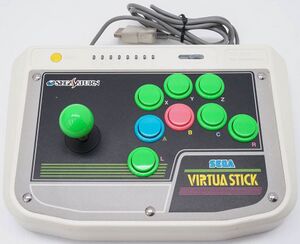
Discussions between Nintendo and Sony for a CD-based add-on to the Super Famicom had broken down, and Sony had decided to go it alone. It announced the PlayStation, a "32-bit" CD-based console similar to the Saturn, due to arrive in Japan in late 1994 - the same period as the Saturn. Feeling they could take Sony with one fell swoop, the Saturn was rushed to the market, just six weeks ahead of the PlayStation. Very few games being available when the Saturn launched — Sega's Virtua Fighter, Sega/Micronet's WanChai Connection, Electronic Arts Victor's Mahjong Goku Tenjiku, Sunsoft's port of Myst, and Time Warner Interactive's Tama.
Despite all of this, 170,000 machines were sold the first day. The Sega Saturn quickly surpassed the popularity of any Sega console released before it in Japan. Part of this success was due to strong, inspiring adverts featuring Segata Sanshiro, who would travel around Japan and punish those who did not play their Saturns. While Saturn systems were being outsold by PlayStation systems in Japan in 1995-1997, Sega actually sold more software for the Saturn during the same time period. The result was that in Japan the Saturn became the platform of choice for more dedicated gamers while the PlayStation had an audience comprised of more casual customers who bought fewer titles.
Japan had numerous Saturn models available within its lifespan of varying colours. It can be seen as one of the first systems to offer a choice in colour - a practise that would later be expanded on further by the Nintendo 64.
In the end the vast majority of the Saturn's game library remained exclusive to Japanese customers. More than 80% of the console's 1000+ strong library did not leave the country.
All this considered, the Sega Saturn is widely regarded as the most popular Sega platform of all time in Japan, selling more than the also-popular Nintendo 64 (6 million vs. 5.54 million). The console was supported with software until 2001, almost three years after the Dreamcast launched in that region.
North America
The US Saturn was also rushed to the market and released four months ahead of the scheduled release date to gain a lead on the release of the Sony PlayStation. This gave third party developers no time to get their games translated and out to market by launch; and the surprise of the rushed release meant only Sega titles were ready at the time of launch. This tactic, among other things, led to the Saturn failing in the marketplace in the US region.
Before word of the PlayStation's earlier release, the release day in the US was to be 'Saturnday' on September 2, 1995. Not only did the announcement of an early release take third-party software developers by surprise, it also meant that Sony would have more time to put some finishing touches on their PlayStation, draw up a well-planned strategy and learn from the pitfalls of the Saturn. This is seen by Sony's tactic on their release date when PlayStation slashed its price to $299, making it $100 cheaper than the Saturn. This move, along with much better marketing than that of Sega of America, wreaked havoc on the Saturn's place in the market and ultimately caused its downfall.
In May 1995, Sega launched the Saturn in the United States, a full 6 months ahead of schedule. This was announced at that year's E3 (Electronic Entertainment Expo), where Sega representatives were engaged in a public relations battle with Sony. Also, Sega chose to ship Saturn units only to selected retailers. This caused a great deal of animosity toward Sega from unselected companies, including Kay-Bee Toys.
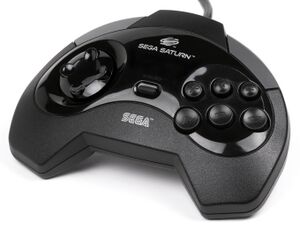
Over time, Sega also changed its marketing strategy, and the successful rebellious advertising campaign of the Sega Mega Drive (for example, the Sega Scream television commercials) was toned down and exchanged for advertisements which took on a more conservative attitude.
Perhaps the biggest contribution to the system's failure was the distrust that gaming consumers were developing for Sega after a series of add-on peripherals to the Sega Mega Drive (Genesis in the US), the Mega CD and 32X, which were discontinued after only lukewarm support. The Sony PlayStation also had many more popular software titles much earlier in the race than Sega did, such as ports of Namco's Ridge Racer which was technologically superior to Sega's Saturn release of Daytona USA. Cost was also a factor, with the Saturn initially costing US $400 compared to the PlayStation at US $300.
Unfortunately, many of the games that made the Saturn so popular in Japan such as the Sakura Taisen series or many of the quirky anime style RPGs that sold well in Japan were never released elsewhere. Much of the reasoning behind this was due to policies put in place under the management of former Sega of America president Bernie Stolar, who believed that RPGs were never to have great commercial success in North America.
Sega's flagship character and mascot, Sonic the Hedgehog, never made a particularly major Saturn appearance - an enhanced Mega Drive port, a racing game and a compilation of his major Mega Drive adventures were made, but only the racing game was exclusive and it was hardly a major title. In fact, the one truly major title (Sonic X-treme) wound up being canceled.
180,000 Saturn units were sold in North America before the PlayStation. 100,000 PlayStation units were sold within its first few days.
Europe
Once again the Sega Saturn was launched early in Europe - this time in July of 1995, a few months before the PlayStation. Until this point, all Sega consoles supplied to Europe had been a success, thanks to little marketing and delayed releases from Nintendo, however newcomer Sony would not follow in Nintendo's footsteps, and gave the region a constant supply of new, high quality titles.
The momentum for Sony's console built up rapidly and consumers seemed less interested in Sega's console than in previous generations. However, Sega's console was kept in the UK race by the very well written Sega Saturn Magazine, with November 1998's Deep Fear being the last game to be released in this region.
Unlike previous consoles which require physical mod chips, the Saturn simply requires an Action Replay cartridge in order to run software from overseas. This made importing games from Japan a much easier process.
Brazil
Like previous consoles, the Sega Saturn was distributed by Tectoy, and eventually adopted many of the colour schemes set out by Sega of Japan. Though not a commercial failure fewer Saturn games were released than Master System or Mega Drive games, with a vast number being US imports.
South Korea
The Saturn was also released in South Korea by Samsung as the SamsungSaturn (삼성새턴). It is rumoured that there are at least two revisions of the console - original models had a faulty reset button which did not function.
Asia
Much like previous consoles, the Saturn had a patchy release across Asia, seeing a release in nations such as Thailand and Hong Kong. A special Saturn with VCD support was released in this "region".
Decline (outside Japan)
After the holiday shopping season in 1996, the Saturn had fallen far behind the PlayStation and Nintendo 64 in North America and Europe, and senior management at Sega wanted to produce a new platform get the jump on the next generation of systems ahead of their competitors. The result was that by E3 1997 Sega had already begun talk of the new system, code named Katana, which would eventually turn into the Sega Dreamcast.
Sega started aggressively moving the Katana project forward and caused something of a rift between Sega and many third party developers. The Saturn was more than holding its own in the Japanese marketplace where the vast majority of Sega game development was based. As a result many Japanese developers saw little to no reason for Sega to rush another platform to the market, which would hurt the Saturn despite its large user base and many active development projects.
The Saturn frequently benefited from the experimental period of early 3D gaming: quadrilateral-based polygons (which the Saturn employed) were, for a while, just as widely used as the triangle-based model of the PlayStation and later consoles, so some Saturn ports fared better than their PlayStation counterparts. By 1997, this was no longer the case; most developers had moved to the easier to manipulate triangles, and future Saturn ports came to be seen as lesser versions. Sega's console still had the edge on 2D graphics, but western developers were no longer interested in producing 2D games. So, after another third place turnout during the 1997 Holiday season, a number of third party publishers started cancelling titles; as a result many games planned for a US Saturn release, including renowned titles such as Policenauts and Lunar The Silver Star Story did not see Western releases.
A chain reaction of cancellations rushed through the Saturn market transforming a seemingly promising 1998 schedule of North American releases into the near-end of the console; a similar situation happened in Europe. The Saturn would be finally discontinued in late 1998 for Europe, and April 3, 1999 in North America. It became yet another poor decision from Sega that would damage the Dreamcast's reputation, with notable publishers such as Electronic Arts refusing to back the system, having made losses on the Saturn (though Sega was able to make up for it well with their various 2K Sports series).
In the end, it was (and still is) widely considered that the Saturn was simply not up to the task of competing effectively in the fifth generation of video game consoles, despite the potential to do so; it simply "wasn't built for 3D games", yet this was the expected standard throughout the latter half of the '90s.
Estimates for the Saturn's worldwide console sales range from 9.5 million to 17 million. [2] It was something of a success, but its failures are believed to have directly contributed to the larger failure of the Dreamcast, despite that console's then and current popularity.
Game Packaging
Japanese Packaging
Japanese Saturn software usually came packaged in standard jewel cases, much like music CDs. They also came with spinecards - three-fold pieces of light cardboard that hug the spine of the jewel case. These are very valuable for collectors who wish to claim a game is "complete". The spinecard also indicates that the CD is for use with a Sega Saturn console - specifically Japanese NTSC systems. There were also jewel case quad CD cases, and a variant of the single case which was slightly thicker and VERY hard to replace.
Most of the time the spinecard will have a gold and black background with the Japanese Saturn logo and lettering printed vertically. Saturn collection games will have red and white spinecard with white lettering, the Saturn Collection logo under that, and the 2,800 yen price featured prominently. Manual is included with the cover seen through the front of the jewel case. The left side of the manual will usually have a bar similar in design to the spinecard. The Japanese SEGA rating, if there is one, will be included on the manual front (usually on one of the corners). There is also the insert on the back which may feature artwork or screenshots from the game. A black bar on the bottom of the insert contains information much like the spinecard, licensing information, et cetera.
The Japanese packaging was adopted in smaller Asian markets such as South Korea and China.
North American Packaging

The US used much larger jewel cases identical to the US Sega Mega-CD jewel cases, since many of these were in fact leftover Sega CD jewel cases. The US case has a white spine containing a 30 degree stripe pattern in gray, with white outlined lettering displaying the words "Sega Saturn". Oddly some US packaging seems to have taken a step backwards in terms of aesthetics - with minimal front artwork almost akin to the Sega Master System.
There are many flaws with the US packaging:
- Their sheer size made them more vulnerable to cracking.
- The mechanism that keeps the cover closed wears out quickly if the cover is opened and closed too much
- There is too much empty space inside the case. If the CD ever came off the case's spindle on its own (caused by rough handling of the case), the CD ends up being tossed around the inside of the case, causing either huge amount of scratches on the disc from careful handling of the case or shattering the disc from continued rough handling of the case.
European Packaging
European cases come in two variants, both designed and engineered by Sega. One has a strong plastic design similar to the cases used with the Mega Drive and Master System (but taller, thinner and slightly more secure). The other feels far cheaper, being literally two pieces of plastic held together by a cardboard cover. Though the former was more preferred by the consumer, the latter was more common as it was cheaper to produce.
Both European cases has a solid black spine, with white lettering displaying the words "Sega Saturn". The manual slides in the case just like a normal jewel case and there is a back insert with information about the game. Like the American cases they are still too big and can lead to discs moving about and becoming scratched, though this may be to compensate for large multi-language manuals.
Some European boxes were wrapped in a transparent plastic shell after manufacture for extra security.
Brazillian Packaging
Brazilian games were packaged in cardboard boxes, with a CD sleeve inside to keep the disc secure.
Emulation
The Saturn is notoriously hard to emulate due to its complex architecture (dual processors, etc.), but three notable emulators do exist:
- SSF is a highly compatible emulator, which is in continual development by a single developer.
- GiriGiri was initially based on an abandoned emulator by Sega themselves, and was considered the best until development ceased and SSF overtook it.
- Yabause is an open-source effort to create a Saturn emulator.
Software that plays files in the Saturn Sound Format, which stores audio ripped from games, does so through emulation of the audio-related code only.
Launch Titles
Japan
North America
- Clockwork Knight
- Daytona USA
- Panzer Dragoon
- Worldwide Soccer: Sega International Victory Goal Edition
- Virtua Fighter
Europe
Brazil
- Bug!
- Clockwork Knight
- Daytona USA
- Panzer Dragoon
- Virtua Fighter
- Worldwide Soccer: Sega International Victory Goal Edition
Gallery
Promotional Material
Print Advertisements
- Saturn US PrintAdvert 3.jpg
US (Head for Saturn)
- Saturn US PrintAdvert 2.jpg
US (A Little Too Real)
- Saturn US PrintAdvert 1.jpg
US (3)
- Saturn US PrintAdvert 4.jpg
US (4)
- Saturn US PrintAdvert IceCube.jpg
US (Head For Saturn(Ice Cube Variant))
- Saturn FR PrintAdvert.jpg
FR (1)
Pamphlets
Television Advertisements
JP (launch)
US (1)
US (2)
External links
- Sega Saturn Console Information at Console Database
- Dave's Sega Saturn Page - Famous fansite that was extremely popular during the Saturn's heyday (no longer updated).
- Sega Saturn Gamepics at the Video Game Museum.
| Sega Home Video Game Systems | ||||||||||||||||||||||||||||
| 83 | 84 | 85 | 86 | 87 | 88 | 89 | 90 | 91 | 92 | 93 | 94 | 95 | 96 | 97 | 98 | 99 | 00 | 01 | 02 | 03 | 04 | 05 | 06 | 07 | 08 | 09 | 10 | 11 |
|---|---|---|---|---|---|---|---|---|---|---|---|---|---|---|---|---|---|---|---|---|---|---|---|---|---|---|---|---|
| SG-1000 | SG-1000 II | Mega Drive | Mega Drive II | |||||||||||||||||||||||||
| SC-3000 | Mega-CD | Mega-CD II | Genesis 3 | |||||||||||||||||||||||||
| Sega Mark III | 32X | Dreamcast | ||||||||||||||||||||||||||
| Master System | Master System II | |||||||||||||||||||||||||||
| AI Computer | Game Gear | |||||||||||||||||||||||||||
| Saturn | ||||||||||||||||||||||||||||
| Pico | Beena | |||||||||||||||||||||||||||
- ↑ 1.0 1.1 File:Hitachi SuperH Programming Manual.pdf
- ↑ 2.00 2.01 2.02 2.03 2.04 2.05 2.06 2.07 2.08 2.09 2.10 2.11 2.12 2.13 2.14 File:Sega Service Manual - Sega Saturn (PAL) - 013-1 - June 1995.pdf
- ↑ 3.0 3.1 3.2 3.3 3.4 3.5 3.6 File:ST-103-R1-040194.pdf
- ↑ 4.0 4.1 4.2 4.3 4.4 4.5 4.6 4.7 4.8 https://github.com/mamedev/mame/blob/master/src/mame/drivers/saturn.cpp
- ↑ 5.0 5.1 File:HD40491 datasheet.pdf
- ↑ 6.0 6.1 File:ST-077-R2-052594.pdf
- ↑ 7.0 7.1 http://www.consoledatabase.com/faq/segasaturn/segasaturnfaq.txt
- ↑ 8.0 8.1 8.2 8.3 8.4 8.5 8.6 File:ST-013-R3-061694.pdf
- ↑ 9.0 9.1 File:ST-058-R2-060194.pdf
- ↑ 10.0 10.1 File:13-APR-94.pdf, page 8
- ↑ 11.0 11.1 File:HM5241605 datasheet.pdf
- ↑ 12.0 12.1 File:TC514260B datasheet.pdf
- ↑ 13.0 13.1 File:UPD4504161 datasheet.pdf
- ↑ File:HM514270D datasheet.pdf
- ↑ File:SRM20256L datasheet.pdf
- ↑ File:TC574200D datasheet.pdf
- ↑ File:ST-058-R2-060194
- ↑ 18.0 18.1 18.2 htt (Wayback Machine: 2013-01-04 20:29)
- ↑ 19.0 19.1 19.2 19.3 htt (Wayback Machine: 2013-01-04 20:29)
- ↑ File:ST-103-R1-040194.pdf, page 17
- ↑ File:ST-013-R3-061694.pdf, page 149
- ↑ File:ST-238-R1-051795.pdf
- ↑ 23.0 23.1 http://www.sega-saturn.com/saturn/other/satspecs.htm
- ↑ htt (Wayback Machine: 2014-03-18 18:31)
- ↑ File:ST-013-R3-061694.pdf, page 81
- ↑ File:ST-013-R3-061694.pdf, page 119
- ↑ File:ST-013-R3-061694.pdf, page 18
- ↑ File:ST-013-R3-061694.pdf, page 29
- ↑ File:ST-013-R3-061694.pdf, page 75
- ↑ File:ST-013-R3-061694.pdf, page 24
- ↑ File:ST-058-R2-060194.pdf, page 24
- ↑ File:ST-058-R2-060194.pdf, page 23
- ↑ http://segatech.com/technical/saturnspecs/index.html
